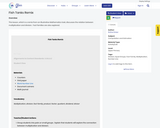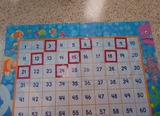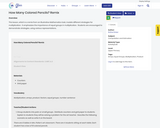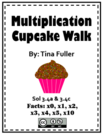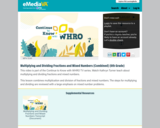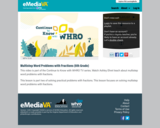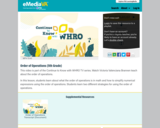In Grade 4 Unit 2, students multiply up to four-digit numbers by one-digit numbers, relying on their understanding of place value and properties of operations, as well as visual models like an area model, to solve.
As a foundation for their multi-year work with multiplication and division, students in Grade 2 learned to partition a rectangle into rows and columns and write a repeated addition sentence to determine the total. They also skip-counted by 5s, 10s, and 100s. Then, in Grade 3, students developed a conceptual understanding of multiplication and division in relation to equal groups, arrays, and area. They developed a variety of strategies to build toward fluency with multiplication and division within 100 and applied that knowledge to the context of one- and two-step problems using the four operations.
To begin the unit, students extend their understanding of multiplication situations that they learned in Grade 3 to include multiplicative comparison using the words “times as many.” Next, to continue to refresh students’ work in Grades 2 and 3 on skip-counting and basic multiplication facts and extend it further to values they have not yet worked with, students investigate factors and multiples within 100, as well as prime and composite numbers (4.OA.4). Thus, this supporting cluster content serves as a foundation for the major work with multiplication and division with larger quantities. Tangentially, it will also support the major work in Unit 5 to recognize and generate equivalent fractions. Then, students move into two-digit by one-digit, three-digit by one-digit, four-digit by one-digit, and two-digit by two-digit multiplication, using the area model, partial products, and finally the standard algorithm, making connections between all representations as they go. The use of the area model serves to help students conceptually understand multiplication and as a connection to their work with area and perimeter (4.MD.3), a supporting cluster standard. Finally, with a full understanding of all multiplication cases, they then apply their new multiplication skills to solve multi-step word problems using multiplication, addition, and subtraction, including cases involving multiplicative comparison (4.NBT.5, 4.OA.3, 4.MD.3), allowing for many opportunities to connect content across multiple domains.
This unit affords lots of opportunities to deepen students’ mathematical practices. For example, “when students decompose numbers into sums of multiples of base-ten units to multiply them, they are seeing and making use of structure (MP.7). Students “reason repeatedly (MP.8) about the connection between math drawings and written numerical work, students can come to see multiplication and division algorithms as abbreviations or summaries of their reasoning about quantities” (NBT Progression, p. 14). Lastly, as students solve multi-step word problems involving addition, subtraction, and multiplication, they are modeling with mathematics (MP.4).
Students’ work in this unit will prepare them for fluency with the multiplication algorithm in Grade 5 (5.NBT.5). Students also learn about new applications of multiplication in future grades, including scaling quantities up and down in Grade 5 (5.NF.5), all the way up to rates and slopes in the middle grades (6.RP, 7.RP). Every subsequent grade level depends on the understanding of multiplication and its algorithm, making this unit an important one for students in Grade 4.
